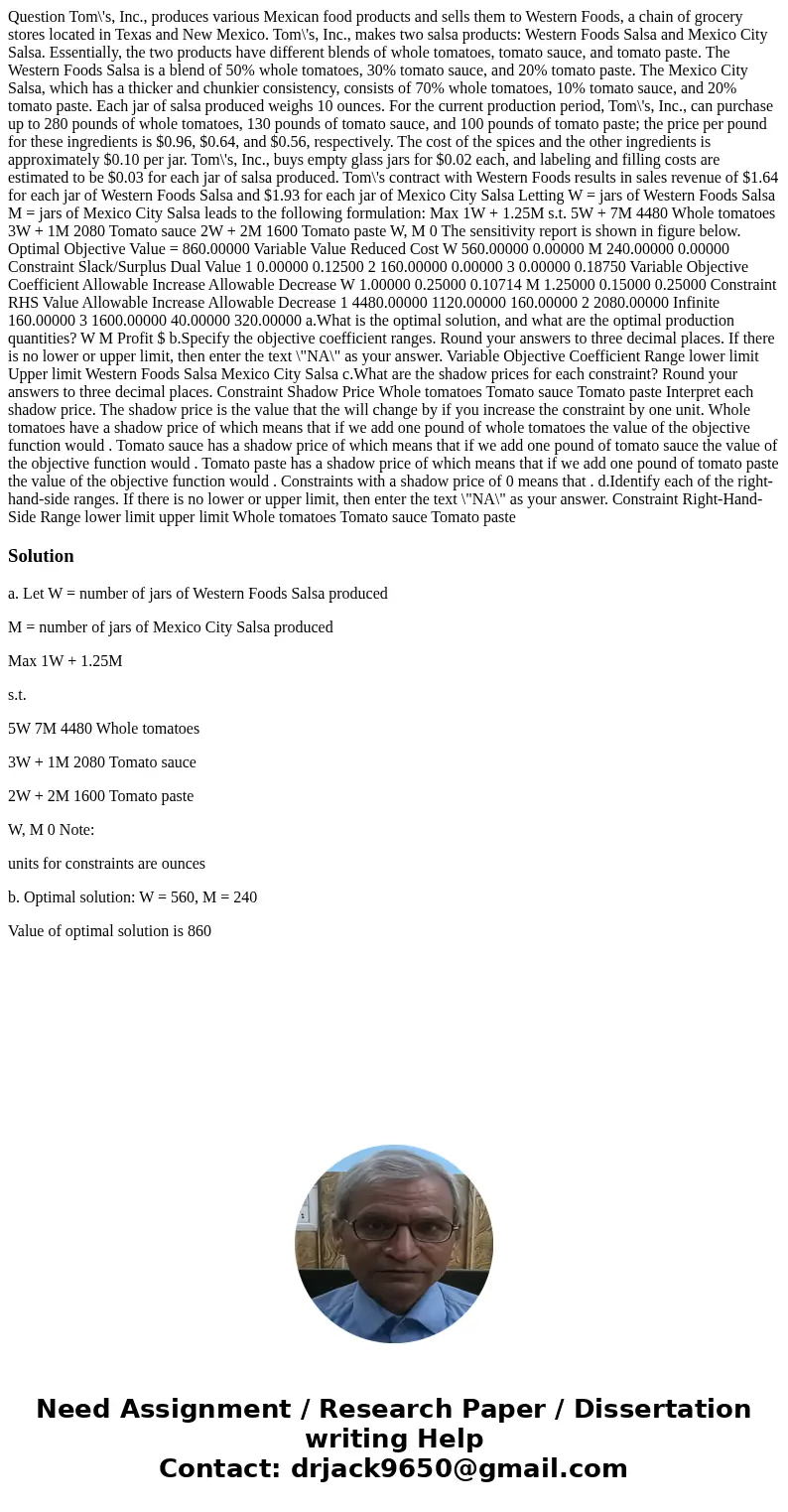Question Toms Inc produces various Mexican food products and
Question Tom\'s, Inc., produces various Mexican food products and sells them to Western Foods, a chain of grocery stores located in Texas and New Mexico. Tom\'s, Inc., makes two salsa products: Western Foods Salsa and Mexico City Salsa. Essentially, the two products have different blends of whole tomatoes, tomato sauce, and tomato paste. The Western Foods Salsa is a blend of 50% whole tomatoes, 30% tomato sauce, and 20% tomato paste. The Mexico City Salsa, which has a thicker and chunkier consistency, consists of 70% whole tomatoes, 10% tomato sauce, and 20% tomato paste. Each jar of salsa produced weighs 10 ounces. For the current production period, Tom\'s, Inc., can purchase up to 280 pounds of whole tomatoes, 130 pounds of tomato sauce, and 100 pounds of tomato paste; the price per pound for these ingredients is $0.96, $0.64, and $0.56, respectively. The cost of the spices and the other ingredients is approximately $0.10 per jar. Tom\'s, Inc., buys empty glass jars for $0.02 each, and labeling and filling costs are estimated to be $0.03 for each jar of salsa produced. Tom\'s contract with Western Foods results in sales revenue of $1.64 for each jar of Western Foods Salsa and $1.93 for each jar of Mexico City Salsa Letting W = jars of Western Foods Salsa M = jars of Mexico City Salsa leads to the following formulation: Max 1W + 1.25M s.t. 5W + 7M 4480 Whole tomatoes 3W + 1M 2080 Tomato sauce 2W + 2M 1600 Tomato paste W, M 0 The sensitivity report is shown in figure below. Optimal Objective Value = 860.00000 Variable Value Reduced Cost W 560.00000 0.00000 M 240.00000 0.00000 Constraint Slack/Surplus Dual Value 1 0.00000 0.12500 2 160.00000 0.00000 3 0.00000 0.18750 Variable Objective Coefficient Allowable Increase Allowable Decrease W 1.00000 0.25000 0.10714 M 1.25000 0.15000 0.25000 Constraint RHS Value Allowable Increase Allowable Decrease 1 4480.00000 1120.00000 160.00000 2 2080.00000 Infinite 160.00000 3 1600.00000 40.00000 320.00000 a.What is the optimal solution, and what are the optimal production quantities? W M Profit $ b.Specify the objective coefficient ranges. Round your answers to three decimal places. If there is no lower or upper limit, then enter the text \"NA\" as your answer. Variable Objective Coefficient Range lower limit Upper limit Western Foods Salsa Mexico City Salsa c.What are the shadow prices for each constraint? Round your answers to three decimal places. Constraint Shadow Price Whole tomatoes Tomato sauce Tomato paste Interpret each shadow price. The shadow price is the value that the will change by if you increase the constraint by one unit. Whole tomatoes have a shadow price of which means that if we add one pound of whole tomatoes the value of the objective function would . Tomato sauce has a shadow price of which means that if we add one pound of tomato sauce the value of the objective function would . Tomato paste has a shadow price of which means that if we add one pound of tomato paste the value of the objective function would . Constraints with a shadow price of 0 means that . d.Identify each of the right-hand-side ranges. If there is no lower or upper limit, then enter the text \"NA\" as your answer. Constraint Right-Hand-Side Range lower limit upper limit Whole tomatoes Tomato sauce Tomato paste
Solution
a. Let W = number of jars of Western Foods Salsa produced
M = number of jars of Mexico City Salsa produced
Max 1W + 1.25M
s.t.
5W 7M 4480 Whole tomatoes
3W + 1M 2080 Tomato sauce
2W + 2M 1600 Tomato paste
W, M 0 Note:
units for constraints are ounces
b. Optimal solution: W = 560, M = 240
Value of optimal solution is 860

 Homework Sourse
Homework Sourse